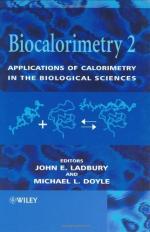|
This section contains 1,188 words (approx. 4 pages at 300 words per page) |

|
Calorimetry is the measurement of the heat absorbed or given off in a chemical or physical change. A device which measures the heat involved in such a change is called a calorimeter.
Historically, among the earliest observations made of chemical changes was that heat was generally involved. Over the years, as investigators attempted to give a rational interpretation for this observation, a number of theories were proposed. Among them were theories which assumed that heat was a material substance, called caloric. Caloric was thought to flow in or out of materials as they changed during chemical transformations. It was necessary to develop methods that were capable of accurately measuring the amount of heat transferred during chemical processes in order for an adequate explanation of the heat phenomenon to be developed.
In 1783, Antoine Lavoisier and P. S. de Laplace (1749-1827) published a description of an ice calorimeter which they...
|
This section contains 1,188 words (approx. 4 pages at 300 words per page) |

|


